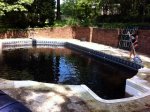Folks! I am looking for input on my present dilemma:
Specifically, I need to know if I can filter the water in my pool after treating with a flocculant. My Dad insisted we shock the pool, filter for 24 hours, and add flocculant to settle out the organic matter in suspension. Well, it's his pool and money, so I honored his request.
In order to mix the added flocculant, I switched the multiport to recirculate, instead of filter, because no one is there to monitor the filter equipment. I am not an expert on flocculant and its effect within the filter. Plainly, I was fearful that the flocculant might cause a major pressure build up and cause equipment damage. So, recirculation seemed a wise choice.
A week later, we are no closer to crystal blue water than we were when we removed the cover. I am sure we have a severe green algae problem, perpetuated by debris at the bottom of the pool. It seems logical that organic matter at the bottom of our pool would only promote further algae growth at a rate that a flocculant is useless with the live algae.
In an aggressive effort to get ahead of the algae bloom, I added 9 gallons of household bleach (sodium hypochlorite) to our pool tonight, attempting to Super Chlorinate and kill some algae. I cannot be certain the concentration of Laura Lynn bleach is strong enough (6%) to work. I will check on it before work in the AM to see if I did any damage.
Filter, filter, filter, 24/7, seems to be the universal advice I have encountered in looking for help on the web. What do you folks think? Can I filter the water in my pool after treating with a flocculant. Adding it, circulating the water for several hours, and shutting off the pump and waiting 24 hours appeared to have NOT dropped any suspend matter to the bottom.
My pool is turbid and really green. I have adjusted the PH and TA to acceptable levels, shocked it repeatedly, and added flocculant without any improvement. What advice do you kind folks have? What should I do next based on the information presented here? I need good advice from solid experience. Let me know if additional information is need to form a recommendation. Thanks!
Dave
Pool Stats are:
- Vinyl Liner
- Size 40x20 Roman
- Volume = approximately 36,000 gallons
- PH = 6.8 - 7.2
- TA = 100
- CYA = ?
- Color = Green as pond water
- Pump and Motor = Pentair WhisperFlo (Model WFE-3) 3/4 HP
- Filter AND Media = Tagelus TA60D Sand Filter filled with Zeosand
Note: When the pool was open 2 years ago, we chlorinated with an Aqua Rite system for Salt Chlorination. Sadly, the system malfunctioned at the end of the season, after only a year of service from the unit. Currently, I have the Turbo Cell removed and stored until I can clear up my pool.
Specifically, I need to know if I can filter the water in my pool after treating with a flocculant. My Dad insisted we shock the pool, filter for 24 hours, and add flocculant to settle out the organic matter in suspension. Well, it's his pool and money, so I honored his request.
In order to mix the added flocculant, I switched the multiport to recirculate, instead of filter, because no one is there to monitor the filter equipment. I am not an expert on flocculant and its effect within the filter. Plainly, I was fearful that the flocculant might cause a major pressure build up and cause equipment damage. So, recirculation seemed a wise choice.
A week later, we are no closer to crystal blue water than we were when we removed the cover. I am sure we have a severe green algae problem, perpetuated by debris at the bottom of the pool. It seems logical that organic matter at the bottom of our pool would only promote further algae growth at a rate that a flocculant is useless with the live algae.
In an aggressive effort to get ahead of the algae bloom, I added 9 gallons of household bleach (sodium hypochlorite) to our pool tonight, attempting to Super Chlorinate and kill some algae. I cannot be certain the concentration of Laura Lynn bleach is strong enough (6%) to work. I will check on it before work in the AM to see if I did any damage.
Filter, filter, filter, 24/7, seems to be the universal advice I have encountered in looking for help on the web. What do you folks think? Can I filter the water in my pool after treating with a flocculant. Adding it, circulating the water for several hours, and shutting off the pump and waiting 24 hours appeared to have NOT dropped any suspend matter to the bottom.
My pool is turbid and really green. I have adjusted the PH and TA to acceptable levels, shocked it repeatedly, and added flocculant without any improvement. What advice do you kind folks have? What should I do next based on the information presented here? I need good advice from solid experience. Let me know if additional information is need to form a recommendation. Thanks!
Dave
Pool Stats are:
- Vinyl Liner
- Size 40x20 Roman
- Volume = approximately 36,000 gallons
- PH = 6.8 - 7.2
- TA = 100
- CYA = ?
- Color = Green as pond water
- Pump and Motor = Pentair WhisperFlo (Model WFE-3) 3/4 HP
- Filter AND Media = Tagelus TA60D Sand Filter filled with Zeosand
Note: When the pool was open 2 years ago, we chlorinated with an Aqua Rite system for Salt Chlorination. Sadly, the system malfunctioned at the end of the season, after only a year of service from the unit. Currently, I have the Turbo Cell removed and stored until I can clear up my pool.



